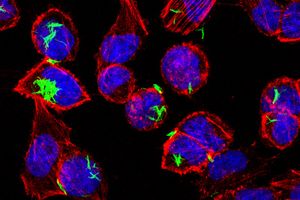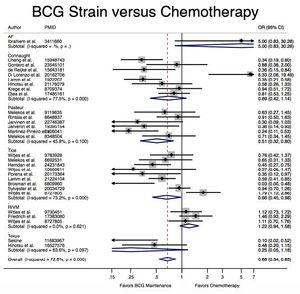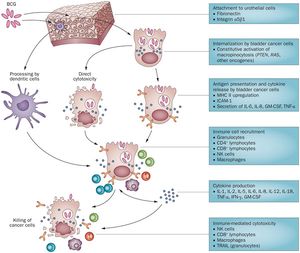Bacillus Calmette-Guérin therapy: Difference between revisions
| Line 40: | Line 40: | ||
For medical use, the virulence of M. bovis must be reduced so as to not lead to infection of the patient during BCG immunotherapy. BCG was first attenuated for use in the BCG vaccine against M. tuberculosis in 1921 by Albert Calmette and Camille Guérin in the Pasteur Institute in Paris, France (See “Other Uses of BCG”) (Boehm et al., 2017). The most common method of attenuation for a bacterial strain is adaptation to a foreign host. The pathogenic bacteria are exposed for periods of time to tissues, eggs, or live specimens of these foreign hosts and allowed to develop mutations that make them better able to survive in the new environment. These mutations make subsequent infection of humans much more difficult, and human pathogenicity of the new strain is decreased. For the creation of BCG from M. bovis, the bacterium was attenuated via serial passage of M. bovis bacteria on glycerol-enriched potatoes (Boehm et al., 2017). The mechanism of attenuation of BCG is not fully understood, as BCG is not a single strain, but rather a collection of substrains that exhibit differing levels of virulence (Liu et al., 2009). However, it is known that attenuated BCG strains contain mutants of several virulence factors of mycobacterium tuberculosis, such as ESX-1 (a virulence factor secretory system), PDIM/PGL (cell envelope localized Mycobacterium tuberculosis lipids and related glycolipids), and PhoP (a transcriptional regulatory protein), making these mutations important for lack of BCG pathogenesis (Liu et al., 2009). | For medical use, the virulence of M. bovis must be reduced so as to not lead to infection of the patient during BCG immunotherapy. BCG was first attenuated for use in the BCG vaccine against M. tuberculosis in 1921 by Albert Calmette and Camille Guérin in the Pasteur Institute in Paris, France (See “Other Uses of BCG”) (Boehm et al., 2017). The most common method of attenuation for a bacterial strain is adaptation to a foreign host. The pathogenic bacteria are exposed for periods of time to tissues, eggs, or live specimens of these foreign hosts and allowed to develop mutations that make them better able to survive in the new environment. These mutations make subsequent infection of humans much more difficult, and human pathogenicity of the new strain is decreased. For the creation of BCG from M. bovis, the bacterium was attenuated via serial passage of M. bovis bacteria on glycerol-enriched potatoes (Boehm et al., 2017). The mechanism of attenuation of BCG is not fully understood, as BCG is not a single strain, but rather a collection of substrains that exhibit differing levels of virulence (Liu et al., 2009). However, it is known that attenuated BCG strains contain mutants of several virulence factors of mycobacterium tuberculosis, such as ESX-1 (a virulence factor secretory system), PDIM/PGL (cell envelope localized Mycobacterium tuberculosis lipids and related glycolipids), and PhoP (a transcriptional regulatory protein), making these mutations important for lack of BCG pathogenesis (Liu et al., 2009). | ||
== | ==Bladder Cancer== | ||
Ranking fourth, bladder cancer is one of the most common types of cancer in men. It was predicted that in the year 2016, almost 77,000 new cases of bladder cancer were responsible for over 16,000 deaths in the U.S. alone (Cookson et al, 1997). Most cases of bladder cancer present as NMIBC, which includes stage Ta (non-invasive papillary carcinoma) and CIS (Carcinoma in situ: non-invasive flat carcinoma) which makes up stage 0, and T1(tumor has grown from bladder lining to connective tissue, but has not yet reached the muscle layer) which makes up stage 1 bladder cancer. For these early stages, standard treatment involves removal of papillary lesions with transurethral resection. However, recurrence rates are high even when it appears as if all cancerous tissue is removed, and secondary treatments in the form of BCG therapy are often used (Pagano et al., 1991). | |||
==Efficacy== | ==Efficacy== | ||
Revision as of 15:46, 28 April 2017
Summary of the Article
By Karina Kunka
This is an overview of a type of immunotherapy used to treat superficial and early-stage bladder cancers, and to prevent recurrence thereof. This particular type of immunotherapy utilizes a strain of attenuated Mycobacterium bovis to stimulate an immune response and cause direct cytotoxicity within the bladder cancer cells. Side effects are common, but typically not severe and manageable. It is the most commonly-used form of immunotherapy and remains a treatment of choice for managing of early-stage bladder cancers, as it is generally very effective at preventing recurrence of bladder cancer when maintenance therapy is used. Bacillus Calmette-Guérin is also used for a vaccine against tuberculosis infection by Mycobacterium tuberculosis in humans, and important new implications for Bacillus Calmette-Guérin use in other types of cancer treatments are up and coming.
At right is a sample image insertion. It works for any image uploaded anywhere to MicrobeWiki.
The insertion code consists of:
Double brackets: [[
Filename: BCG_infected_cells.jpeg
Thumbnail status: |thumb|
Pixel size: |300px|
Placement on page: |right|
Legend/credit: Electron micrograph of the Ebola Zaire virus. This was the first photo ever taken of the virus, on 10/13/1976. By Dr. F.A. Murphy, now at U.C. Davis, then at the CDC.
Closed double brackets: ]]
Other examples:
Bold
Italic
Subscript: H2O
Superscript: Fe3+
Introduce the topic of your paper. What is your research question? What experiments have addressed your question? Applications for medicine and/or environment?
Recent studies have found that the Pak1-dependent pathway activated by oncogenes is actually responsible for uptake of BCG via macropinocytosis.
[1]
[2]
[3]
A citation code consists of a hyperlinked reference within "ref" begin and end codes.
Introduction

Bacillus Calmette-Guérin (BCG) Therapy (Trade name TheraCys®, TICE® BCG) (chemocare.com) is a form of outpatient intravesical immunotherapy for the treatment of bladder cancer. BCG therapy is typically used to prevent noninvasive or minimally-invasive bladder cancers from returning following transurethral resection of bladder tumor (TURBT) (American Cancer Society cancer.org) and is widely considered the most effective prophylactic treatment for patients with non-muscle-invasive bladder cancer (NMIBC) (Babjuk et al., 2011).
Bacillus Calmette-Guérin is a type of attenuated (weakened or non-virulent) Mycobacterium bovis. It was first cultured at the Pasteur Institute in the early 1900s, where it was then subcultured and distributed worldwide. BCG was first used in a vaccination for tuberculosis infection, then later in the 1980’s adopted for use in immunotherapy for treatment of bladder cancer. TICE, Armond-Frappier, and Connaught are the only three FDA-approved BCG strains for use in patients with non-muscle-invasive bladder cancer, but TICE is the only strain actively marketed in the U.S. as of 2017 (Boehm et al., 2017). However, many other strains exist and are used worldwide for the same effect (see: Efficacy).
Mycobacterium bovis
Overview
Mycobacterium bovis is a strain of aerobic, slow-growing bacteria that is the main cause of bovine tuberculosis. It is closely related to Mycobacterium tuberculosis, or the main causative agent of tuberculosis in humans, which can lead to severe infection of the lungs and lymph nodes. M. bovis typically infects cattle, deer, elk, and bison, but it is actually capable of crossing the species barrier and infecting humans with tuberculosis, though it is estimated to cause only 2% of total tuberculosis cases in the United States each year (CDC). Transmission is usually through contaminated dairy products or other products that come from host animals like meat (CDC).
M. Bovis History and Attenuation
For medical use, the virulence of M. bovis must be reduced so as to not lead to infection of the patient during BCG immunotherapy. BCG was first attenuated for use in the BCG vaccine against M. tuberculosis in 1921 by Albert Calmette and Camille Guérin in the Pasteur Institute in Paris, France (See “Other Uses of BCG”) (Boehm et al., 2017). The most common method of attenuation for a bacterial strain is adaptation to a foreign host. The pathogenic bacteria are exposed for periods of time to tissues, eggs, or live specimens of these foreign hosts and allowed to develop mutations that make them better able to survive in the new environment. These mutations make subsequent infection of humans much more difficult, and human pathogenicity of the new strain is decreased. For the creation of BCG from M. bovis, the bacterium was attenuated via serial passage of M. bovis bacteria on glycerol-enriched potatoes (Boehm et al., 2017). The mechanism of attenuation of BCG is not fully understood, as BCG is not a single strain, but rather a collection of substrains that exhibit differing levels of virulence (Liu et al., 2009). However, it is known that attenuated BCG strains contain mutants of several virulence factors of mycobacterium tuberculosis, such as ESX-1 (a virulence factor secretory system), PDIM/PGL (cell envelope localized Mycobacterium tuberculosis lipids and related glycolipids), and PhoP (a transcriptional regulatory protein), making these mutations important for lack of BCG pathogenesis (Liu et al., 2009).
Bladder Cancer
Ranking fourth, bladder cancer is one of the most common types of cancer in men. It was predicted that in the year 2016, almost 77,000 new cases of bladder cancer were responsible for over 16,000 deaths in the U.S. alone (Cookson et al, 1997). Most cases of bladder cancer present as NMIBC, which includes stage Ta (non-invasive papillary carcinoma) and CIS (Carcinoma in situ: non-invasive flat carcinoma) which makes up stage 0, and T1(tumor has grown from bladder lining to connective tissue, but has not yet reached the muscle layer) which makes up stage 1 bladder cancer. For these early stages, standard treatment involves removal of papillary lesions with transurethral resection. However, recurrence rates are high even when it appears as if all cancerous tissue is removed, and secondary treatments in the form of BCG therapy are often used (Pagano et al., 1991).
Efficacy

Mechanism of Action

Conclusion
References
- ↑ Redelman-Sidi et al., "Oncogenic Activation of Pak1-Dependent Pathway of Macropinocytosis Determines BCG Entry into Bladder Cancer Cells." 2013. Cancer Research 73:3 1156-1167.
- ↑ Hodgkin, J. and Partridge, F.A. "Caenorhabditis elegans meets microsporidia: the nematode killers from Paris." 2008. PLoS Biology 6:2634-2637.
- ↑ Bartlett et al.: Oncolytic viruses as therapeutic cancer vaccines. Molecular Cancer 2013 12:103.
Authored for BIOL 238 Microbiology, taught by Joan Slonczewski, 2017, Kenyon College.
